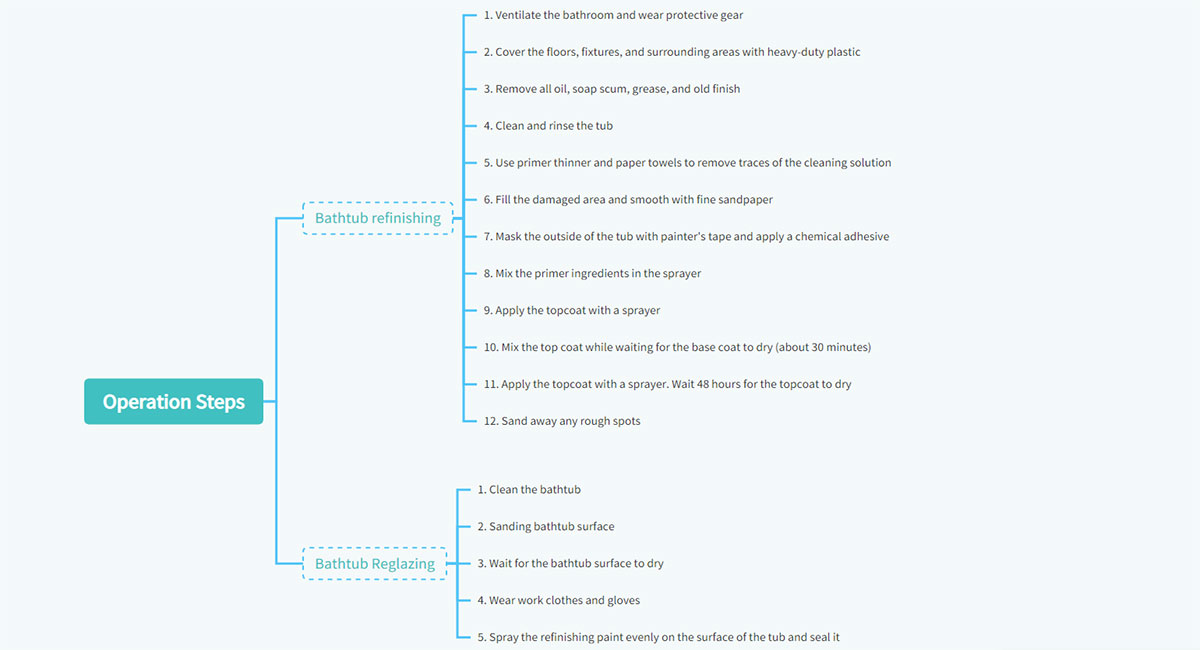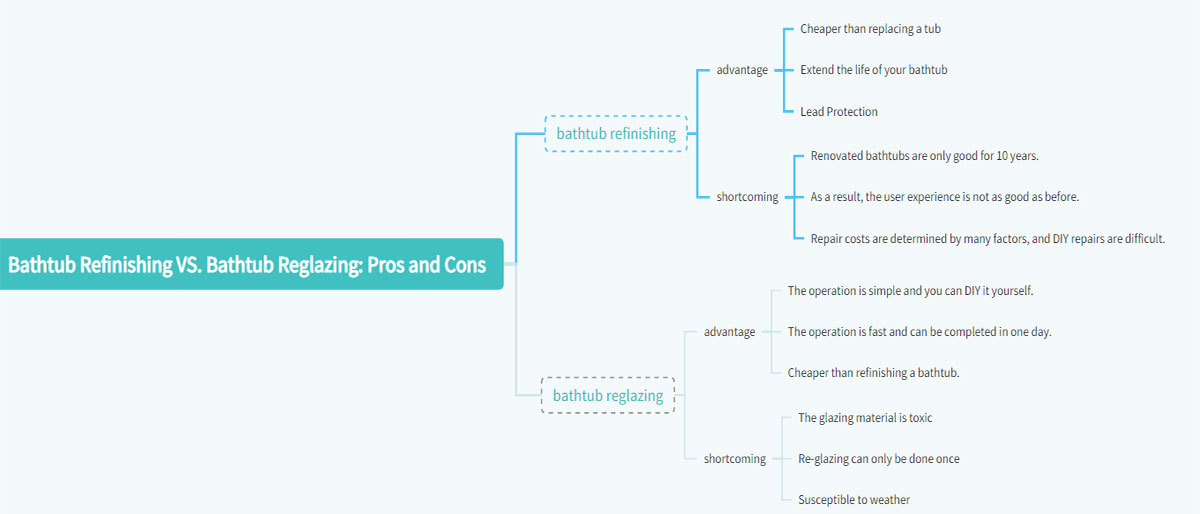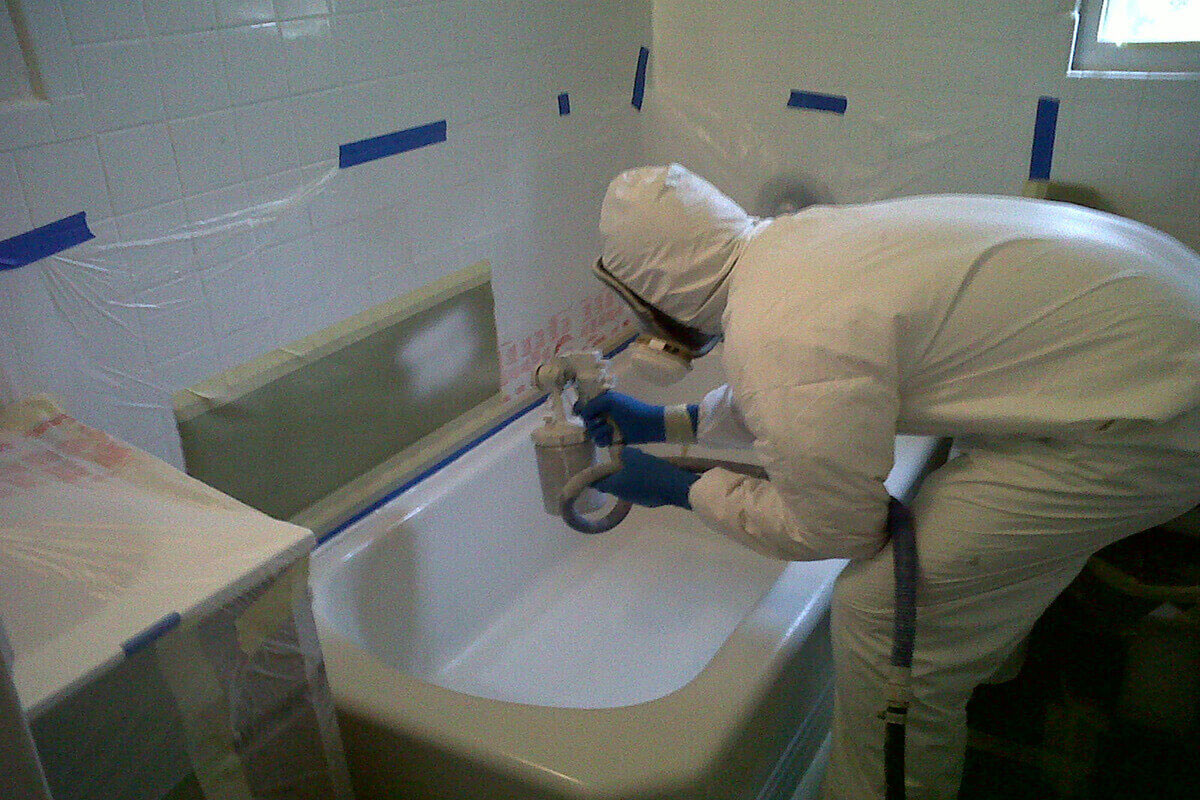When your bathtub develops a crack, have you considered whether to repair it or reglaze it? What’s the difference between them? It’s easy to get confused between these two terms, so in today’s guide, we’re going to explore the differences between the two. Includes definitions, costs, steps, pros and cons, and more. Read on to learn more.
1. Bathtub Refinishing VS. Bathtub Reglazing: Definition
In fact, bathtub refinishing and bathtub reglazing are two different concepts, please see the comparison below.
1) Bathtub refinishing
Bathtub refinishing is a general term that generally encompasses the entire process of refinishing the entire bathtub. Includes repairs, resurfacing, and reglazing. This is a term commonly used by professionals.
2) Bathtub reglazing
Reglazing is just one step in the refinishing process—the last step, to be exact. It refers to adding a smooth layer of paint to the surface of the bathtub to repair the defective surface of the bathtub. It is equivalent to giving the bathtub a facelift and making it look brand new. Depending on the contractor, a tub’s enamel surface can be repaired using enamel paint or two coats of epoxy.
To summarize, the main difference between “tub refinishing” and “tub reglazing” is that the former refers to the entire restoration project, while the latter refers to the commercial coating applied at the end of the process.
(Looking for a reliable bathtub manufacturer? Your request will be met.)
2. Bathtub Refinishing VS. Bathtub Reglazing: Operation Steps
There are also differences in the steps involved in bathtub refinishing and bathtub reglazing.
1) Steps to bathtub refinishing
- First, ventilate the bathroom with an exhaust fan to move toxic fumes outside. Wear protective gear, including goggles, gloves, and a respirator to avoid toxic chemicals.
- Second, cover the floors, fixtures, and surrounding areas with heavy-duty plastic.
- Third, prepare the tub surface using a cleaning solution and 240-grit sandpaper to thoroughly remove all oil, soap scum, grease, and old finish.
- Fourth, clean and rinse the tub. Then, use a second solution and a scouring pad to roughen the surface so the coating will adhere better. Clean the tub thoroughly and dry with paper towels.
- Fifth, use primer thinner and paper towels to remove traces of the cleaning solution.
- Sixth, use two-part filler putty and a putty knife to fill in damaged areas, such as chips or scratches. Let the putty dry for 30 minutes, then sand it smooth with fine sandpaper. Wipe away dust with primer thinner and paper towels.
- Seventh, mask the outside of the tub with painter’s tape and apply a chemical adhesive.
- Eighth, mix the primer ingredients (primer, catalyst, and reducing agent) in a sprayer according to the manufacturer’s instructions. Connect the sprayer to the compressor.
- Ninth, apply the topcoat with a sprayer. Wearing a respirator is critical. A piece of cardboard can be used as a practice surface for using the sprayer.
- Tenth, mix the top coat while waiting for the base coat to dry (about 30 minutes).
- Eleventh, apply the topcoat with a sprayer. Wait 48 hours for the topcoat to dry.
- Finally, use extra-fine 1,500-grit sandpaper to sand away any rough spots.
2) Steps to bathtub reglazing
- When cleaning the bathtub, the bathtub surface must be thoroughly clean and free of oil and soap scum.
- Sand the tub surface, any debris must be filled with putty and completely sanded smooth.
- Wait until there is no moisture on the surface of the tub.
- Wear coveralls and gloves to avoid contact with touch-up paint.
- Spray the refinishing paint evenly on the surface of the tub and seal it.
Please note: Refinish paint fumes are hazardous and require adequate ventilation with an organic vapor respirator.
(Another related post: A Buying Guide for Freestanding Bathtubs)
3. Bathtub Refinishing VS. Bathtub Reglazing: Cost
There is also a cost difference between bathtub refinishing and bathtub reglazing, see the comparison below for details.
1) Bathtub refinishing
First, the cost of bathtub repair will depend on the condition of the damage.
#1. Classify according to the condition of the bathtub
The cost of refinishing a bathtub depends on the condition of the bathtub and can range from $200 to $1,000. For example, if your bathtub is in good condition with only minor wear and tear. Then the cost of repair will be lower. On the other hand, if your tub has serious damage, it will cost more to repair.
#2. Classification by bathtub material
If you are planning on refinishing your bathtub, the cost of refinishing your bathtub will actually vary depending on the material. Here’s a comparison of clawfoot tub and shower combos.
(1) Clawfoot Tub Repair Cost
According to research, clawfoot tub refinishing costs approximately $300 to $650. The specific price depends on many factors, including condition, complexity of repair, size of the tub, and installation location. Clawfoot tub refinishing typically involves stripping off the old coating, repairing any damage, and applying a new coating.
(2) Repair costs for bathtub and shower combinations
According to research, the cost of refinishing a bathtub shower combination ranges from approximately $500 to $1,000. The specific price depends on the size of the equipment, the degree of damage, the materials used in the replacement combination, etc. Shower combo refinishing can make your bathroom look brand new. A tub shower combination remodel includes refinishing the tub, shower walls, and fixtures. These steps may make the process slightly more complicated and time-consuming compared to renovating a freestanding tub.
#3. Divide by specific repair methods
Depending on the type of damage and condition of the bathtub, repairmen will use different repair methods. This can also create a difference in price. Different refinishing techniques such as sanding techniques, re-glazing kits, and chemical stripping techniques. These technologies may have different associated costs. Of course, there are other methods of refinishing, such as tub inlays or tub liners. This may require more extensive preparation, materials, and labor, increasing the overall cost.
#4. Bathtub customization
The cost of bathtub refinishing will also vary depending on whether your bathtub is custom-made. If your bathtub is specially customized, the color, size, and shape are all specially produced by the bathtub manufacturer. Then when repairing, you need to hire professional maintenance personnel to repair and use customized materials. These can increase the overall cost of your tub repair. On the other hand, if your bathtub is not custom-made, you can use common materials when repairing it, and you don’t even need to hire a professional repairman. This saves costs to a certain extent.
2) Bathtub reglazing
The biggest determining factor in the cost of reglazing a bathtub is the material of the tub. Here are the reglazing costs for bathtubs made of different materials.
#1. Fiberglass Tub Reglazing Cost
Currently, fiberglass bathtubs are chosen by most homes due to their durability and wide range of design styles. The cost to reglaze a fiberglass tub ranges from approximately $300 to $1,000. But the exact cost still depends on factors such as size and condition. Additionally, fiberglass tubs cannot be reglazed multiple times, so this should only be used as a temporary solution.
#2. Cast Iron Tub Reglazing Cost
The cost to reglaze a cast iron tub ranges from $350 to $650. Since a cast iron bathtub contains cast iron, its surface can easily rust. The process of reglazing a cast iron bathtub involves sanding the surface and applying a strong enamel paint.
#3. Ceramic Tub Reglazing Cost
The cost to reglaze a ceramic tub is approximately $475. Ceramic bathtubs are actually much easier to reglaze than other bathtubs, as most ceramic bathtubs consist of a thin layer of porcelain on top of cast iron. However, if your ceramic bathtub is made of solid porcelain, then it is most likely an antique. In this case, you need to find a repairman who has similar repair experience.
Your tub will be even more valuable if it is a clawfoot ceramic tub. But the cost of reglazing this type of bathtub will also be much higher than the cost of reglazing a regular ceramic bathtub. Probably between $500 and $1,200. Although expensive, reglazing a ceramic clawfoot tub can extend its lifespan by about 10 to 15 years.
(Another related post: Bathtub Refinishing FAQ Guide)
4. Bathtub Refinishing VS. Bathtub Reglazing: Pros and Cons
Here’s a comparison of the pros and cons of tub refinishing versus tub reglazing.
1) Advantages and disadvantages of bathtub refinishing
advantage:
Cheaper than replacing a tub: Bathtub refinishing can make a broken tub look like new but at a fraction of the cost of replacing it with a new one.
Extend the life of your bathtub: If you really like your current bathtub and can’t find a new one to replace it. Then you can refinish the tub to extend its life. Economical and effective, this is the best option. Bathtub refinishing can eliminate common problems like rust, corrosion, detergent damage, and mold. Not to mention, bring your tub back to life.
Lead Protection: There are many reasons to renovate your bathtub. Of these, the ability to protect your family from the dangers of lead exposure is undoubtedly an important one. Bathtub refinishing creates a protective layer over the wires, preventing them from leaking and contaminating you or your family. Refinishing can also help your tub look like new again.
shortcoming:
- Renovated bathtubs are only good for 10 years.
- As a result, the user experience is not as good as before.
- Repair costs are determined by many factors, and DIY repairs are difficult.
2) Advantages and disadvantages of bathtub reglazing
advantage:
- The operation is simple and you can DIY it yourself.
- The operation is fast and can be completed in one day.
- Cheaper than refinishing a bathtub.
shortcoming:
- The substances professionals use to reglaze your tub can be a bit dangerous. The materials used for etching and glazing are very toxic and you will need to leave the house for a day or two so that the house can ventilate properly.
- Re-glazing can only be done once. If you have reglazed your tub, you may want to consider replacing it.
- Weather can affect how long it takes for the topcoat to dry and how well it bonds to the surface. Humidity is detrimental to the entire process, so it’s best to avoid tub refinishing during the dog days of summer. The cool, wet weather typical of fall or spring provides ideal conditions.
(Another related post: A Complete Guide for Freestanding Tub)
5. Frequently asked questions
Here are answers to frequently asked questions about bathtub repair and bathtub reglazing.
1) When does a bathtub need to be refinished?
Filling small chips and cracks can stop them from growing larger and prevent more serious structural damage to your tub. If you’re not sure whether your tub could benefit from refinishing or reglazing, look for the following signs.
#1. Crack
Bathtubs are frequently used furniture and if you suddenly see a crack in your bathtub. Then it’s time to find a professional bathtub repairman to refinish your bathtub.
#2. Discoloration
Over time, your tub may become stained or discolored. Hard water, hair dye, chemicals, and bath bombs can all leave stains on your tub surface that cleaning can’t remove. This can make the tub look old and unattractive. Then the bathtub will also need to be refinished or reglazed at this time.
#3. Peeling or bubbling paint
Paint blistering or peeling will only get worse as more water or air enters the tub’s surface. Like scratches, peeling paint can also be a breeding ground for dirt and bacteria.
#4. Rust stains
Rust is one of the most common bathtub refinishing problems. Tubs made of steel or cast iron have a porcelain or enamel coating, but if the coating peels or cracks, it may begin to rust. Rust often spreads and can damage the surface finish of large areas if not detected and removed promptly.
2) How to hire professional maintenance personnel?
If you need to find a professional bathtub repairman, then you need to understand what you should consider when looking for a professional repairman. Here are some of our suggestions.
Check out customer reviews: Check out the contractor’s Better Business Bureau page as well as customer reviews on Trustpilot and Google. Companies with a long history of customer satisfaction are a safe bet, as are those with high ratings from the Better Business Bureau.
Ask for multiple quotes: Different repairmen will give different quotes for the same situation, so it’s best to get a few quotes before making your final choice.
Request samples: After you find a contractor you are happy with, you can ask them for some repair samples or browse historical projects on their official website.
3) Is a bathtub renovation worth it?
I once had a friend who manufactures desktop calculators ask me this question. I replied: “If there is only minor cosmetic damage to the tub, it may be worth refinishing it. This is a more cost-effective alternative to adding a liner or installing a new tub. Just like your calculator is missing just one button, you just need to replace it with a new one.” However, patching does not repair major damage. All in all, a bathtub is worth renovation.
4) How long does a bathtub reglazing last?
A tub reglaze can last 10 to 15 years, depending on the materials used, whether the surface has been professionally treated, and how well the tub is cleaned and maintained. If done correctly, a reglazed tub will look like new, and contractors will typically offer a warranty of 3 to 10 years.
How to extend the life of your refurbished bathtub:
- Avoid abrasive cleaners, bleach, and steel wool, which can cause scratches, discoloration, and damage to the coating.
- The surface of the tub should not be used to store shampoo bottles or other products.
- Do not use suction cup mats on the bottom of the bathtub. When reglazing your tub, ask your contractor to provide a non-slip coating.
- Avoid reglazing the tub yourself, as a DIY kit may only last two years.
5) Is it dangerous to reglaze a bathtub?
Reglazing a bathtub can be a dangerous process, especially if you’re doing it yourself. Because the fumes emitted during the stripping process produce methylene chloride, a harmful fume that releases volatile organic compounds that can be fatal in extreme cases. So when removing and reinstalling bathtub glass, it’s important to open the windows and maintain proper airflow. It is recommended that you find professional maintenance personnel to perform the operation.
(Another related post: Bathtub Buying Guide)
6. Conclusion
Bathtub refinishing and reglazing are both steps you can take to give your bathtub a new look. If you are on a tight budget, it is best to choose one of these two. This article summarizes the differences between bathtub refinishing and reglazing, and hopefully, after reading this you will know which one to choose. If you have further questions, please contact Nicemoco.
How useful was this post?
Click on a star to rate it!
Average rating 5 / 5. Vote count: 4
No votes so far! Be the first to rate this post.













